

- Call 908 543 4390
- Email
- Dr.Joni Redlich PT,DPT


Navigating the first year of your baby’s life is filled with joy, challenges, and milestones. Among these milestones are crucial motor skills developments. As a parent, witnessing your baby not meeting these milestones can be worrying. Often, you’re advised to take a ‘wait and see’ approach, which can be frustrating.
In this blog, we’ll guide you through understanding the importance of early motor milestones, what it means if there’s a delay and actionable steps you can take to ensure your baby’s healthy development and progress.
Motor milestones are key developmental markers that indicate your baby’s progress in physical abilities during their first year.
These milestones reflect the growth of muscle strength, coordination, and motor skills essential for a child’s overall development.
They include skills like rolling over, sitting up without support, crawling, standing, and eventually walking.
These milestones are not just physical achievements; they are essential to cognitive and social development, laying the foundation for future learning and interaction.
The journey through motor milestones begins with head control and progresses through a series of stages: from rolling over to sitting, crawling, standing, and walking.
Each step is a sign that your baby is developing their muscle strength and coordination.
Knowing this order helps you keep an eye on your baby’s progress and spot if they might need a little extra help along the way.
Understanding the impact of delays in motor milestones is important. For example, if your baby takes longer to start crawling or walking, this might affect how they learn to move around and understand space, which is a big part of how they learn and play.
If you notice that your baby isn’t hitting these milestones on time, it’s a good idea to not just wait and see. Talking to us early can help you figure out what’s going on and make sure your baby gets the right support.
To speak to one of our experts for FREE, arrange a discovery visit at our specialist clinic by clicking HERE.
Knowing when to worry about your baby’s development is crucial.
If your baby is not meeting milestones as expected, or if they start losing skills they had before, it’s time to take action.
Getting help soon can really make a difference in your child’s growth and their abilities in the future rather than a wait-and-see approach, as this can leave your child falling behind, and struggling to take part in activities with their friends.
If you have worries about how your baby is developing their motor skills and have been putting off coming to see us, we invite you to speak to our expert team for FREE.
We have a limited number of slots available at our clinic, but we are currently offering a special opportunity for a Free Development Screening for Motor Milestones.
This assessment isn’t just a check-up; it’s a valuable chance for you to get a clear picture of where your baby stands in their motor development journey.
Our team will take the time to understand your baby’s unique needs and discuss any concerns you might have. From there, we can guide you towards the most effective treatment options, designed to support your baby’s growth in a comfortable, stress-free way.
To schedule your Free Development Screening for Motor Milestones and take the first step in ensuring your child gets the best start in life, click HERE or call us on 908 543 4390.
Schedule Your Free Development Screening For Motor Milestones
Read our blog – Babies & Head Control: What To Look For & How To Help
Read our blog – Crawling: Does It Still Matter?
On social media? Then Like Our Facebook Page or Follow Us On Instagram for more helpful tips and advice.
Torticollis is a condition that can make the start of your baby’s life a challenge – with difficulty sleeping, self-soothing, and feeding.
But in this article, you can learn about a cuddle-friendly, tear-free torticollis treatment that has worked wonders for the parents, and baby’s at our specialist New Jersey clinic.
Torticollis is like an uninvited guest that disrupts your child’s early journey. It’s marked by a persistent tilt or turn of the head, and it can wreak havoc on their development.
You might also notice that your child hates tummy time, and has an uneven head shape due to the constant pressure on one particular area.
But don’t worry; you’re not alone in this.
Many parents like you face the same challenges, and there are natural, safe, and proven treatments for torticollis.
When you’re looking to treat torticollis in your baby, it’s too common for parents to be told to “Just wait and see” which is an incredibly frustrating piece of advice to be given – you don’t want to wait and I totally understand.
Another common thing parents will be told is to “Watch YouTube for neck stretches” and then be expected to miraculously perform these safely and effectively at home…
That’s difficult for any untrained person.
Let alone a parent who is dealing with a screaming, wriggling baby, and feeling terrified about hurting their little one during these stretches.
Despite the flaws in the “wait and see” and “do it yourself” approach, it’s often something parents do initially.
But the cost of not treating torticollis as early as possible can be significant for your child.
Ignoring it or relying solely on neck stretches that you try to do alone and inconsistently can lead to delays in both visual and gross motor development, as well as physical adaptions.
Children with untreated torticollis can often struggle in later life to keep up with their peers in terms of motor skills and coordination, sensory skills, and visual development.
And this can have a big impact on their self-esteem and confidence at school due to their difficulty completing tasks others can manage with ease.
There is also the physical adaptions that a persistent head tilt can result in.
Baby’s heads are very malleable and when they are constantly sleeping, and putting pressure on one part of their head, the shape of the head and skull can change result in a flat spot.
Again, as well as the physical impact, there is an emotional impact to having a flat spot on their head which could be avoided with the right treatment for their torticollis.
But here’s the good news: there’s a groundbreaking approach that can change the game for your child.
It’s something we’ve used in our specialist clinic for many years, and been life-changing for babies with torticollis, and ended a lot of stress, worry and anxiety for parents too.
It’s called Total Motion Release (TMR).
And addresses Torticollis with a whole-body approach.
By looking at the whole body, we can identify whether their torticollis is caused by tightness in the mouth, a tongue tie issue, or tightness in the pelvis from being squished in your uterus for nine months.
In many cases, the tightness that is causing the head tilt is not the only area of tightness in the body, and it often occurs because of another part of the body – such as the pelvis.
When our expert team uses this whole body approach, we can deliver sessions that treat torticollis in a fraction of the time, ensuring it doesn’t impact your baby long-term.
Plus, this approach is much more gentle, with no painful stretching, and no tears.
That means treatment is a much more enjoyable experience for parents and their babies.
If your child has been diagnosed with torticollis and you’ve not received the treatment your baby needs, or you’re just noticing the warning signs of torticollis and haven’t been to your doctor, here is an invitation to speak to our expert team for FREE.
Demand at our clinic is very high, but we are creating 5 spaces for Free “No Stretch” Screenings For Torticollis.
This is a 100% free appointment designed to help you understand what’s happening with your baby, and how you can help them overcome torticollis before it leads to long-term consequences.
Plus, the right treatment plan can offer very quick results so you can soon get to more enjoyable tummy time, fewer tears during the night, and an easy time feeding for your little one.
To schedule your Free “No Stretch” Neck Screening for Torticollis and take the first step toward your child’s brighter future, click HERE or call us on 908 543 4390.
Schedule Your Free “No Stretch” Screening For Torticollis
Then download a copy of our free expert report – A Parent’s Guide To Torticollis – which contains 5 stress-free strategies to solve stubborn head tilts & turns.
It’s a digital copy and will arrive in your inbox as soon as you’ve entered your details.
Read our blog – Torticollis – A Tearless Approach To Treatment
Watch our video – Torticollis and Total Motion Release (TMR)
On social media? Then Like Our Facebook Page or Follow Us On Instagram for more helpful tips and advice.
Every child is unique, and so are their sensory experiences.
For some children, the world can be an overwhelming place due to a condition known as Sensory Processing Disorder.
As parents, caregivers, and educators, it’s our responsibility to provide the support and understanding these children need to thrive.
In this guide, you can learn about Sensory Processing Disorder and explore effective strategies to help children with Sensory Processing Disorder not just cope, but thrive in the sensory-rich world we live in.
Sensory Processing Disorder is a neurodevelopmental condition that affects the way the brain processes and responds to sensory information.
Sensory experiences are a fundamental part of our daily lives, encompassing everything from the taste of food to the feel of clothing against our skin and the sounds of the environment.
However, for children with Sensory Processing Disorder, these sensory inputs can become overwhelming or distorted, leading to stress, frustration and meltdowns in their daily lives.
A Sensory Processing Disorder can manifest in various ways, including:
Your child may be hypersensitive to sensory stimuli.
And this can mean that they may react strongly to even mild sensations, such as certain textures, bright lights, or loud noises.
For you, and your child, this can make it really difficult when going into new environments, which are outside of your control, and lead to fear, anxiety, or tantrums.
In contrast, your child may be hyposensitive, meaning they have a reduced awareness of sensory stimuli.
They may seem oblivious to temperature changes, physical pain, or even their surroundings.
And while this may seem less of a challenging situation it can lead to harmful consequences – they don’t realize how cold it is when they’re playing out, or don’t realize they’ve injured themselves when playing on their bike.
Another way Sensory Processing Disorder can impact your child’s life is that they are more likely to seek out sensory experiences than others.
So when they’re being shouted at, and told to sit still at their desk in class, their instincts are desperate for stimulation which means they are fidgeting, or seem like they can’t sit still.
For your child, this is very hard to understand because they are craving stimulation, yet being punished and feel bad for seeking it.
It’s easy to see why children with sensory disorders can lose their confidence and self-esteem.
Is your child struggling to tell the difference between different textures, tastes, or sounds?
This could be another way that a sensory processing disorder is impacting their life, and often can be seen in kids who are labeled “fussy eaters”.
Often, kids prefer to stick to bland or neutral-flavored foods because they can’t differentiate different tastes and prefer to stick to the familiar and safe options – especially when their confidence is low or they are feeling anxious.
Living with a Sensory Processing Disorder can be emotionally challenging for not just your child, but also your family.
But it’s important to recognize that their frustration, anger, and behavior are their way to navigating through a world that is very different to that, you and I go through.
Their emotions are valid.
And a natural response to their unique sensory experience.
Importantly, your child isn’t broken, and doesn’t need fixing, despite what you made be made to feel by people who don’t understand.
However, while your child doesn’t need fixing, you can help them to cope, and thrive throughout their life with the right support.
Seek Guidance From Experts
Start by consulting with a pediatrician or occupational therapist who specializes in sensory processing issues. The team at our specialist clinic in New Jersey can give you an accurate diagnosis, and provide you and your child with the specialized and personalized support they need.
You can find out more about this in a Free Sensory Processing Screening by clicking HERE or calling us on (908) 543 4390.
Create a Sensory-Friendly Environment
You know your child better than anyone, so make adjustments to your child’s surroundings to reduce their sensory triggers.
This might include using soft lighting, noise-canceling headphones, or providing sensory-friendly tools like fidget toys.
Celebrate Small Victories
For children with special needs, life can be a very demoralizing place.
What is easy for other kids in their class, is incredibly difficult for them – through no fault of their own.
So when they do achieve something, no matter how small, make sure to celebrate.
Building their self-esteem and confidence is essential to their overall well-being.
Establish a Sensory Diet
Work with a therapist to develop a sensory diet tailored to your child’s needs.
This involves incorporating sensory activities into their daily routine to help them build their confidence, and regulate their sensory experiences with things that can be challenging for them.
One important thing is to not make the experience stressful for them, and if they are struggling, to move to something that they are stronger at doing.
Your child will develop much faster if you make it fun, and get them engaged rather than pushing them to do things they aren’t capable of doing.
Advocate for Your Child
Another way to help is to advocate for your child at school and in social settings.
Try to work closely with educators and therapists to ensure they receive appropriate accommodations and support.
Empathy and Patience
Understand that your child’s reactions are not intentional.
Be patient, empathetic, and validate their feelings.
And when they do have tantrums, provide a safe space for them to express themselves.
I know it can be very difficult, especially out in public with lots of strangers watching and judging, but do your best to keep calm and help them through their experience.
Education and Awareness
Educate yourself, your child’s teachers, and caregivers about your child’s Sensory Processing Disorder.
The more people understand your child’s needs, the better they can provide support.
And with the right support, your child can start to regulate their response to sensations that used to trigger them much better, or have plans in place to reduce the impact.
If you’re recognizing the behaviors in your child in this blog, even to a small degree that hasn’t led to an official diagnosis, we can help you get a much deeper understanding of the condition and the best ways to help your child move forward.
We appreciate that you are worried for your child.
How they cope in school.
How they interact with other kids in the neighborhood or at the park.
And what their future will look like.
But one way to begin to relieve your anxiety over this is to learn more.
And speaking to our experts for FREE is something we would invite you to do.
Right now, demand at our New Jersey clinic is very high, and we only have a limited number of spaces available for our Free Sensory Processing Screenings.
This appointment gives you 1-1 time with a leading expert, at our popular clinic, and allows you to share your story, get answers, and find out proven ways to support your child.
Call us now on (908) 543 4390 or click HERE to book yours.
Read our blog – Sensory Processing Disorders – Getting To The Core Of It
Read our blog – Top Tips For Sensory Savvy Parents
On social media? Then Like Our Facebook Page or Follow Us On Instagram for more helpful tips and advice.
With kids returning to school soon, do you find yourself having sleepless nights worrying about how they’ll handle it?
And do you worry that they are going to fall behind their classmates further?
Lots of parents go through these emotions.
But it’s often much worse for parents of children with special needs.
And it can be a lonely time too.
Because as a parent of a child with special needs, it’s hard to find people who truly understand what you’re going through.
And that’s before we even consider how your kid is feeling…
Special needs children have to deal with the normal challenges every child faces in school, plus the additional challenges their conditions create.
Perhaps they struggle to concentrate in class, which means that they find it difficult to learn at the same pace as the other students.
Or they might have a hard time coping with the busy corridors, packed cafeterias, and hectic playgrounds.
And it can leave your child feeling isolated, getting upset, or unable to learn.
One reason that kids struggle for longer than they need to is our first myth…
This “wait and see” approach is incredibly frustrating for both parents and children because it’s so passive.
Even if your child will improve if left to their own devices, wouldn’t it be better to support them to accelerate their development, and help them become independent sooner?
For a lot of children with special needs, unless they get the right support, they will remain stuck.
Unable to progress.
And this is why the myth that your kid will grow out of it, or improve on their own is so harmful and misguided.
This is a damaging myth because alone, this won’t work for many children with special needs.
While it is great to have your child enjoy a sport, play with the neighbors’ kids, and get outdoors, it’s unlikely to be everything they need.
A child with special needs deserves special care, and a unique approach is where the real progress happens.
So if your child is struggling in school, forcing them to join a sports team or packing your calendar with playdates isn’t the answer.
The final myth is another frustrating one because it’s so unfair.
Most children are trying as hard as they can, using their all energy, and failing.
And over time this really wrecks their confidence and self-esteem.
I’ve heard so many stories about parents and teachers motivating children by giving them rewards and pushing them to try harder, and not seeing any progress.
But what you want to do instead is start to focus on what your child can do.
And working on their strengths, as opposed to focusing on their weaknesses.
When we do this in our clinic, progress is often surprisingly quick because we take an approach that your child hasn’t experienced before.
And this also helps to rebuild your kids’ confidence if they’ve spent years being told that they need to try harder.
At our specialist clinic, we have a proven track record of helping children with special needs and a team of leading experts to help your family.
But we appreciate parents want to find out more before deciding on visiting us.
That’s why we offer Free Telephone Consultations where you can speak to our friendly team and share your story.
From this point, we can give you personalized advice, and let you know about the best options available to support your child’s development.
So if you’re child is struggling in school or having tantrums on the way to school, we can help!
And because this is a telephone consultation, you can speak to us from the comfort of your own home!
What are you waiting for?
Simply click HERE to arrange your free telephone consultation now, or call us on (908) 543 4390
Read our blog – Why The School-Based Therapy Your Child Receives Doesn’t Seem To Be Helping
Read our blog – Struggling To Focus In The Classroom? 6 Tips To Help Kids Stay Focused
On social media? Then Like Our Facebook Page or Follow Us On Instagram for more helpful tips and advice.
In summer, you may be one of the many families that are trying to make the most of the warmer weather and visit beaches, parks, and playgrounds with their kids.
But as a parent of a child with special needs, things are VERY different for you.
Rather than relaxing and chatting with the other moms and dads as the kids go off and play together…
You’re terrified in case they fall off the climbing frame or trip over as they run and hurt themselves.
For you, getting outdoors is actually a really stressful time, and you don’t feel like you can let them play on their own – even if they want to.
It’s tough for parents of kids with neurological disorders as well.
If your child struggles to interact and communicate, this can lead to them getting frustrated and having tantrums, or being left out of games by the other kids.
Worst of all is the fear of them being bullied by mean kids.
And a time that is supposed to be fun, and a highlight of your week is actually a lot of stress, anxiety, and worry.
A lot of parents who reach out to us have children who are receiving some form of therapy in school.
And they are frustrated that it’s not helping their child develop fast enough (or at all).
We understand that it’s frustrating, but it’s really important to remember two things about school-based therapy that your child is going to.
At schools, therapy is often once a week for 30 minutes. This even includes the often 5 minute walk to and from the therapy room, leaving very little time for real work to get done.
This really is not a lot of time for your child to get the specialized care and attention that they need to make progress.
And many kids will struggle to make significant progress with such infrequent appointments.
At our specialist clinic, we have a wide variety of treatment options and facilities available.
This means that we are able to help a wide variety of children with different needs.
Schools often have minimal equipment and treatment options, so unless your child is lucky and just happens to suit what’s offered, it can be really difficult for them to make progress.
The main objective of school-based therapy is to help your child succeed in their school environment.
Getting to and from lessons, carrying their backpacks, eating their lunch, and behaving so they aren’t disrupting the other students are some of the main goals.
And while this is understandable for the school to focus on this, it doesn’t really help you outside of school.
Certainly, some improvements will carry over to other areas of your child’s life.
But when kids are in new environments, this can mean that they go back to square one and it feels like they’ve not made much progress for all their time and effort in school-based therapy.
Since 2016, KidPT has helped thousands of children with a variety of developmental challenges move better, learn faster and enjoy themselves more by becoming confident, independent, and capable.
As a parent of a child with special needs, I know you’ve seen lots of doctors, been given lots of advice, and may feel a little lost.
You want what’s best for your child.
You want them to be able to play safely and keep up with their peers.
You want them to feel more confident talking, interacting, and joining in with playtime.
And you also want to feel happier too – knowing that your family is able to enjoy more special moments at the park, on vacation, and at the beach.
So here’s what to do, to get a much clearer picture of the best steps for your child…
Arrange A Free Discovery Session with our expert team who can listen to you and your child’s story, learn about your family, and give you our expert guidance on the best services suitable for their needs.
From here, you will feel much more in control.
And you can decide what the next steps are.
Simply click HERE to arrange your free discovery session now, or call us on (908) 543 4390
Read our blog – Top Tips For Sensory Savvy Parents
Read our blog – 10 Fun Occupational Therapy Activities To Try At Home
Follow us on social media… Like Our Facebook Page or Follow Us On Instagram for more helpful tips.
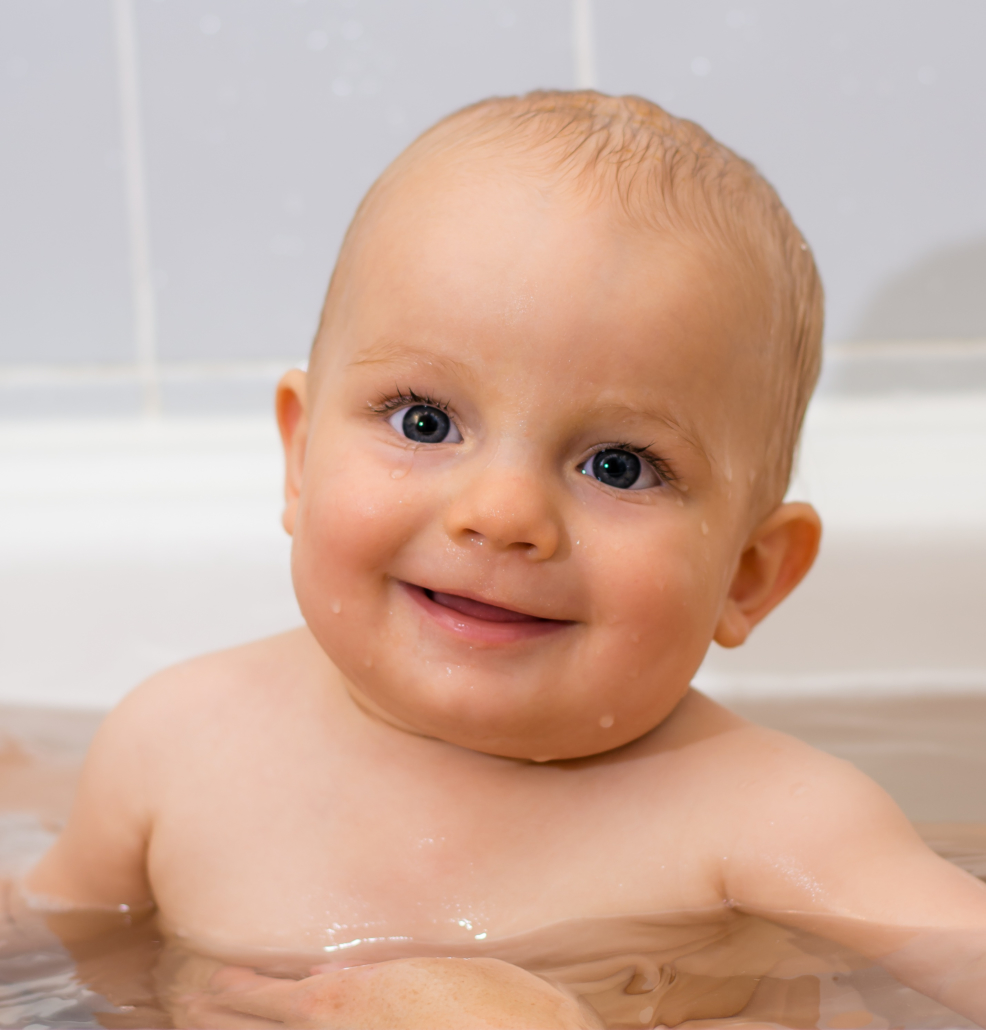
Babies have just spent 9 months growing and developing in the womb, where they were just floating around!
As newborns, they are fully reliant on mom and dad to support where their bodies go and what they see, hear, touch and smell.
With practice, new experiences, and time, babies develop head control through a combination of increased muscle strength and coordination. As they grow, infants begin to control the movements of their head by strengthening the muscles in their neck, upper back, and throughout their bodies. They also learn to coordinate the movement of their head with their eyes, which allows them to fixate on objects and track movement. This stimulates the development of the vision system, which also develops as a result of movement experiences. Additionally, as babies spend time lying on their backs, lying on their stomachs, and even being carried, they have the opportunity to practice lifting and controlling their head movements.

Babies typically begin to hold their heads up by themselves around 3-4 months of age. This is a significant milestone in their development, as it indicates that they are gaining control over the muscles in their neck and upper back. However, it’s important to note that all babies develop at different rates, and some may start holding their heads up earlier or later than others. Some babies may be able to hold their heads up briefly as early as 2 months, while others may not be able to hold their heads up until they are 5 months old. It is important to also be mindful if a baby was born prematurely. We want to consider the skills of a baby who was born prematurely in comparison with their adjusted age and not just their chronological age.
It’s important to remember that skills will develop as babies have the opportunity to try out new skills. That means that babies need lots of time to experiment with movement! The best way to do that is on the floor on a blanket with both toys (consider black and white toys or cards for our youngest of babies) and also with us. Get down on the floor with baby to play and if there is a big brother or sister, have then get in on the action too. If you have barriers to getting down on the floor to play, you can do the same play activities on a couch where you can be sitting more comfortably.

Here are our Kid PT top 3 positions that can be helpful for babies to strengthen their necks:
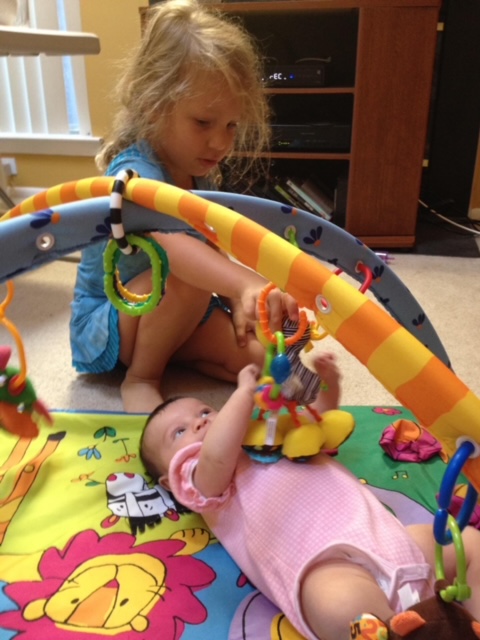
If your baby is struggling to hold their head up during tummy time or prefers to look in one direction, it is best to seek out professional advice. At Kid PT, Dr. Joni always tells parents that when they come in for a free screening they will either learn how to help their child or they will get piece of mind that everything is ok. There is nothing to lose!
To learn more about the developmental process in the first year and understand what to expect as your little one learns to move, check out Dr. Joni’s free guide, The 6 Keys to Gross Motor Development In the First Year. The goal of this guide is to help parents find out when their baby just needs more time and when their baby may need some help to meet their milestones!
If your worries about your baby’s development are keeping you up at night (and we know how precious sleep is right now!), then we would like to invite you to come in for a Discovery Visit to meet with one of Kid PT’s physical therapists. At a Discovery Visit, we will talk about your concerns and make a look at your baby’s movement skills.
You can request for a free visit HERE.
Do you want to learn more about pediatric physical therapy and what it is. You can read more about it here. I know as a parent it can scary to take your baby to a new medical appointment. Rest assured that our visits are generally filled with smiles, giggles, and play. Babies have no idea they’re “working”, but just know they’re having fun. In fact, one of our top values at Kid PT is for the therapeutic process to be not just effective from a movement perspective, but for it to be as easy and positive as can be along the journey.
If you have any questions, we are here for you. You can call us at (908) 543-4390 or email Dr. Joni directly at joni@kidpt.com.
Just remember parents, you go this!
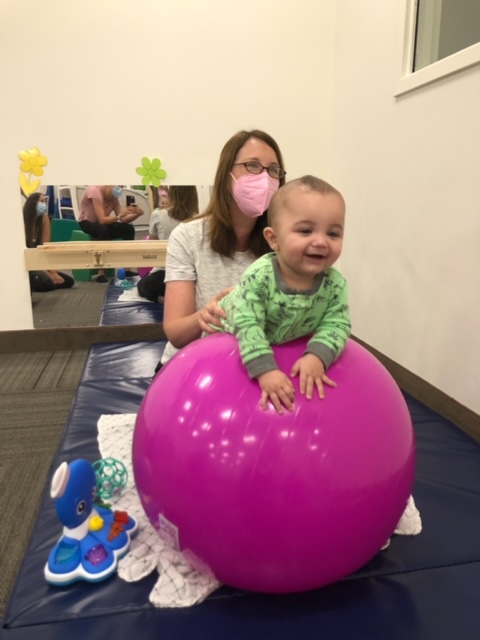
Spinal muscular atrophy (SMA) is a genetic disease that affects the central nervous system, peripheral nervous system, and voluntary muscle movement (skeletal muscle). A majority of nerve cells that control muscles are located in the spinal cord. SMA primarily affects muscles, because they don’t receive signals from specific nerve cells, called motor neurons. When muscles aren’t stimulated by nerve cells, they get smaller or atrophy. Because SMA involves the loss of nerve cells called motor neurons in the spinal cord, it is classified as a motor neuron disease.
Degree of motor function decrease is roughly correlated to the age at which SMA symptoms start. Generally, kids who have symptoms at birth or in infancy usually have the lowest level of functioning (type 1). As a rule, later-onset SMA with a less severe course (types 2 and 3, and in teens or adults, type 4) corresponds with progressively higher levels of motor function.
Chromosome 5 SMA is caused by a deficiency of a motor neuron protein called SMN, for “survival of motor neurons”, which appears necessary for normal motor neuron function. SMN has a crucial role for gene expression in motor neurons.
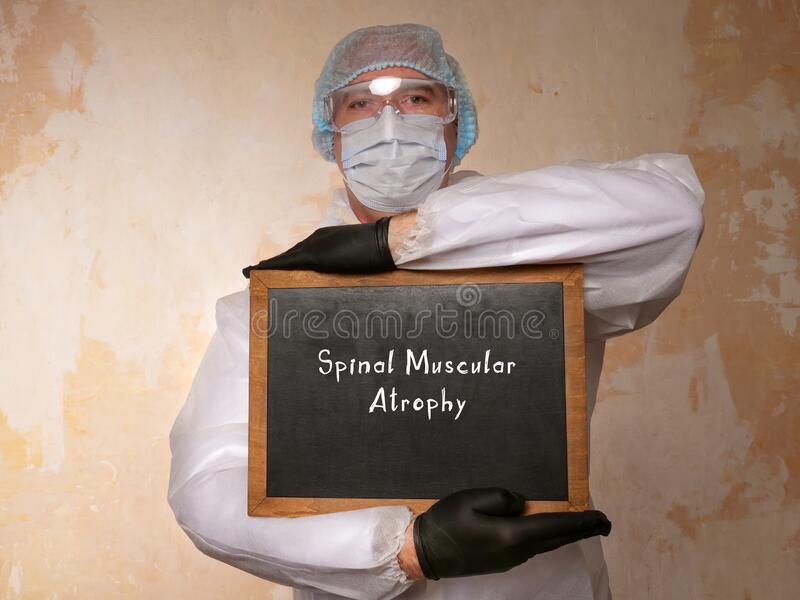
The scope of SMA symptoms are broad, and symptoms range from mild to severe. Typically the “proximal” muscles (closer to the center of the body) are the most affected in the body. SMN-related SMA presents with weakness of the voluntary muscles as a primary symptom and often include shoulders, hips, thighs, and upper back. Lower limbs seem to be more than upper limbs, and there is a decrease in deep tendon reflexes. If the muscles used for breathing or swallowing are impacted, there may be complications with those functions. Similarly, back muscles weakening may result in development of spinal curvatures.
Recently, there have been exciting treatments for various types of SMA that have been complete game changers for individuals who have the disease. Current research strategies have focused on increasing the body’s production of the SMN protein that’s lacking in the chromosome 5-related forms of SMA. Methods include approaches to increase motor neuron survival in adverse circumstances.
The Food and Drug Administration (FDA) approved Spinraza (nusinersen) for the treatment of SMA, on Dec. 23, 2016. Spinraza is designed to treat the underlying defect in SMA, meaning it potentially might be effective at slowing, stopping, or possibly reversing the symptoms of SMA.
In May 2019, the FDA approved Zolgensma (onasemnogene abeparvovac-xioi), which represents the first gene-replacement therapy for a neuromuscular disease. Zolgensma is a one-time intravenous infusion, and is used to treat pediatric patients younger than 2 years of age with SMA, who exhibit bi-allelic mutations in the SMN1 gene. This includes those who are presymptomatic at diagnosis. Read more information at: FDA Approves AveXis’ Zolgensma for Treatment of Spinal Muscular Atrophy in Pediatric Patients.
Additionally, the FDA approved risdiplam (brand name Evrysdi) in August 2020, for the treatment of SMA in adults and children two months of age or older. It is an oral medication that functions to raise SMN protein levels, by boosting production from the SMN2 “backup” gene.
For a detailed and simple-to understand overview of SMA, visit the Muscular Dystrophy Association website for the SMA fact sheet at:
https://www.mda.org/sites/default/files/2020/11/MDA_SMA_Fact_Sheet_Nov_2020.pdf
Currently, one of the best known people with SMA is Shane Burcaw. Shane has been affected by SMA most of his life, yet it doesn’t define him fully or keep him from living a productive life as a disability advocate, speaker and author. Together with his wife, Hannah, they run a popular YouTube channel ,“Squirmy and Grubs” and share their relationship story with the world, with the hope to change the way society thinks about disability.
The link below is a video on the channel where Shane talks about his diagnosis and early life. It also showcases the amazing relationship he and his wife share.

The CDC put out new milestone guidance for families and crawling was removed as a milestone. This decision led to a lot of uproar in the pediatric physical therapy and occupational therapy world and a lot of confusion for parents! Let’s have a conversation in this blog post about crawling and whether it is still important for us to consider.
First off, let’s consider the guidelines put out to parents and healthcare professionals. The developmental monitoring guidance, which is designed for parents to have a quick way to see if their child’s development is on track, no longer includes crawling as a milestone.
This does NOT change child development, developmental screening, or developmental evaluations. Developmental screenings are recommended to be done at 9, 18, and 30 months of age. Additionally, Autism Screening is recommended at 18 and 24 months of age. Any concerns about a child’s development will lead to a developmental evaluation, which looks more in depth at a child’s development.
Developmental screenings and evaluations will continue to include crawling as a milestone. Given that, we can include that crawling continues to be a milestone and one that is important to address.
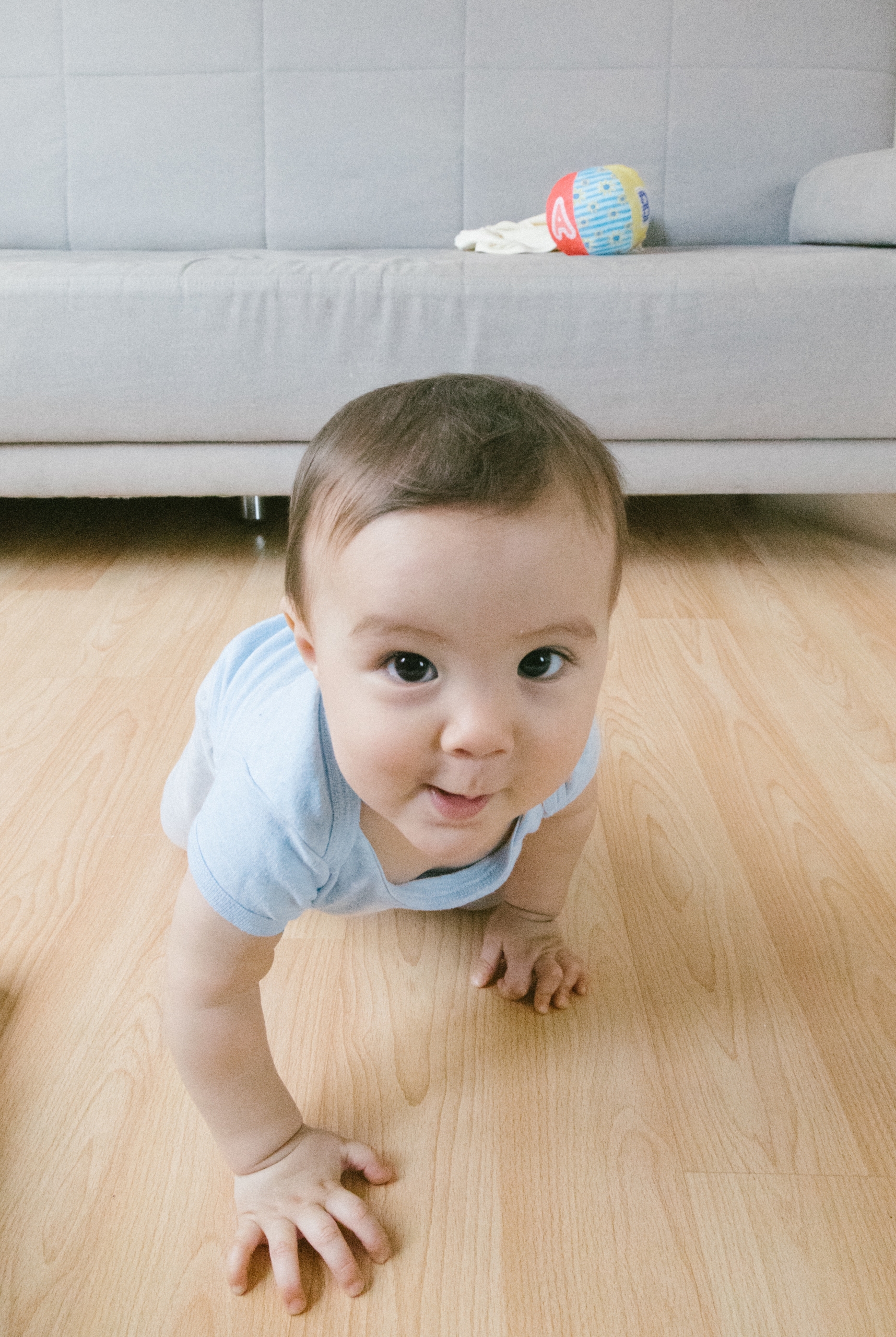
In many ways crawling represents freedom. Crawling is usually the first time a baby can actively explore their environment, versus someone having to carry them from point A to point B. Babies also gain a sense of independence from their parent or caregiver, as they move away from them and then move back.
When babies bear weight on their arms, they develop shoulder stability and they develop the arches of the hands, which helps later on with handwriting and fine motor skills. Crawling also helps develop vision skills and gives babies important sensory feedback, from stimulating the vestibular system while moving in space, gives information to the touch receptors on the hands, legs and feet, and gives proprioceptive information from the joints and muscles. This sensory feedback helps babies develop spatial awareness, or the sense of where their body is in space.
Finally, crawling helps develop core stability and coordination, because you’re using your opposite arm and leg at the same time, along with moving in a rhythmic manner.
All of these components work together as the baby learns to control their bodies against gravity at this new level.
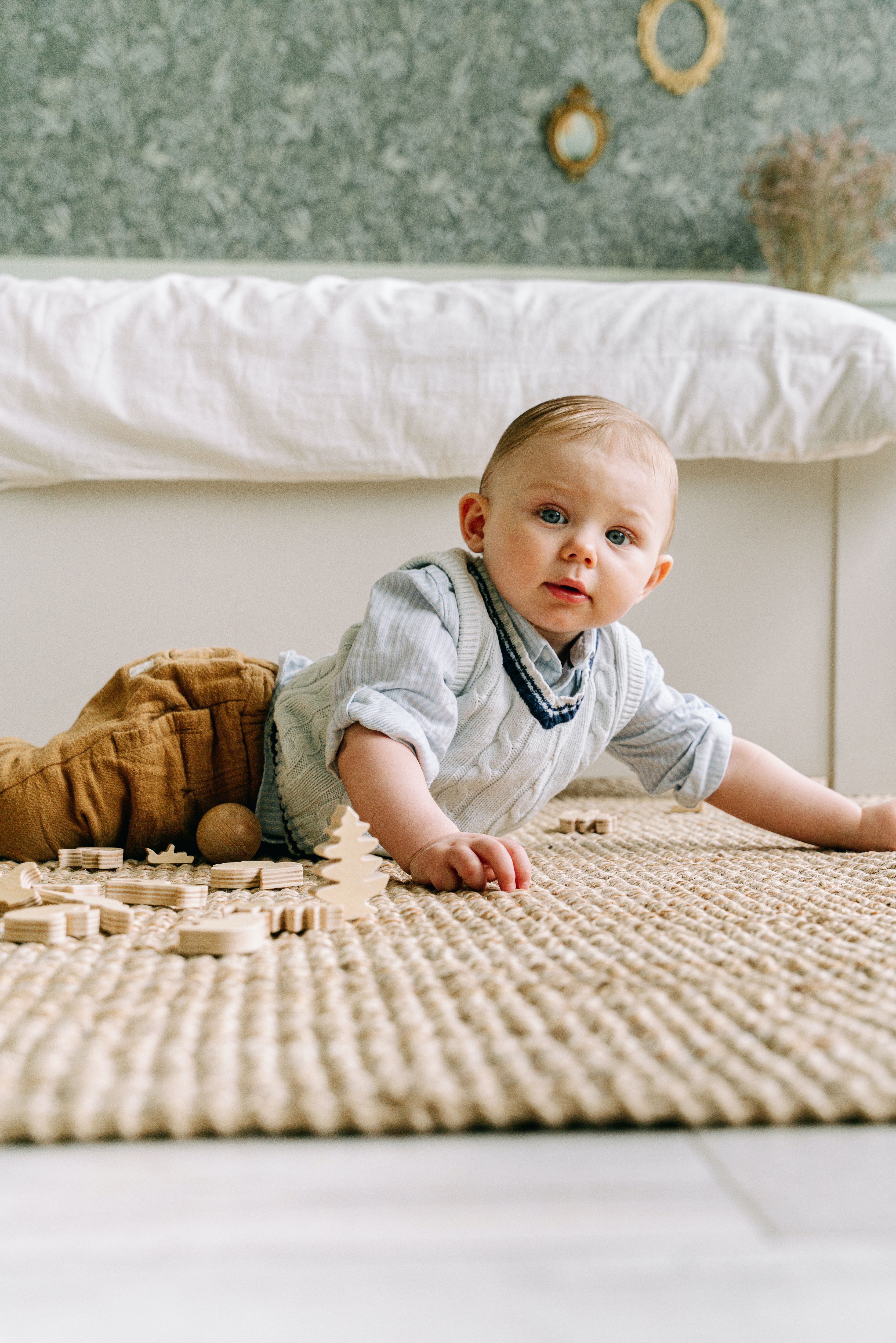
The most important thing parents that do to support their babies development is to have lots of floor time, without the use of supports, so that baby can explore.
Babies need to move against gravity, and see, by trial and error, when I reach for that toy, what happens? A lot of times they start moving by a happy accident, like they lean one way to get something and they roll over. If they don’t have those opportunities, those happy accidents can’t happen.
When the baby is on the floor, encourage them to move by putting toys slightly out of reach. As parents, having the patience to let them go through that trial and error process and not jump in can be so hard, and sometimes even I have to sit on my own hands.
The transitions babies do over and over again during play, moving from sitting to belly and back to sitting, from sitting to hands and knees to sitting again, is what gets their little bodies truly ready for crawling. They move in and out of positions, getting their core muscles primed to support them on hands and knees.
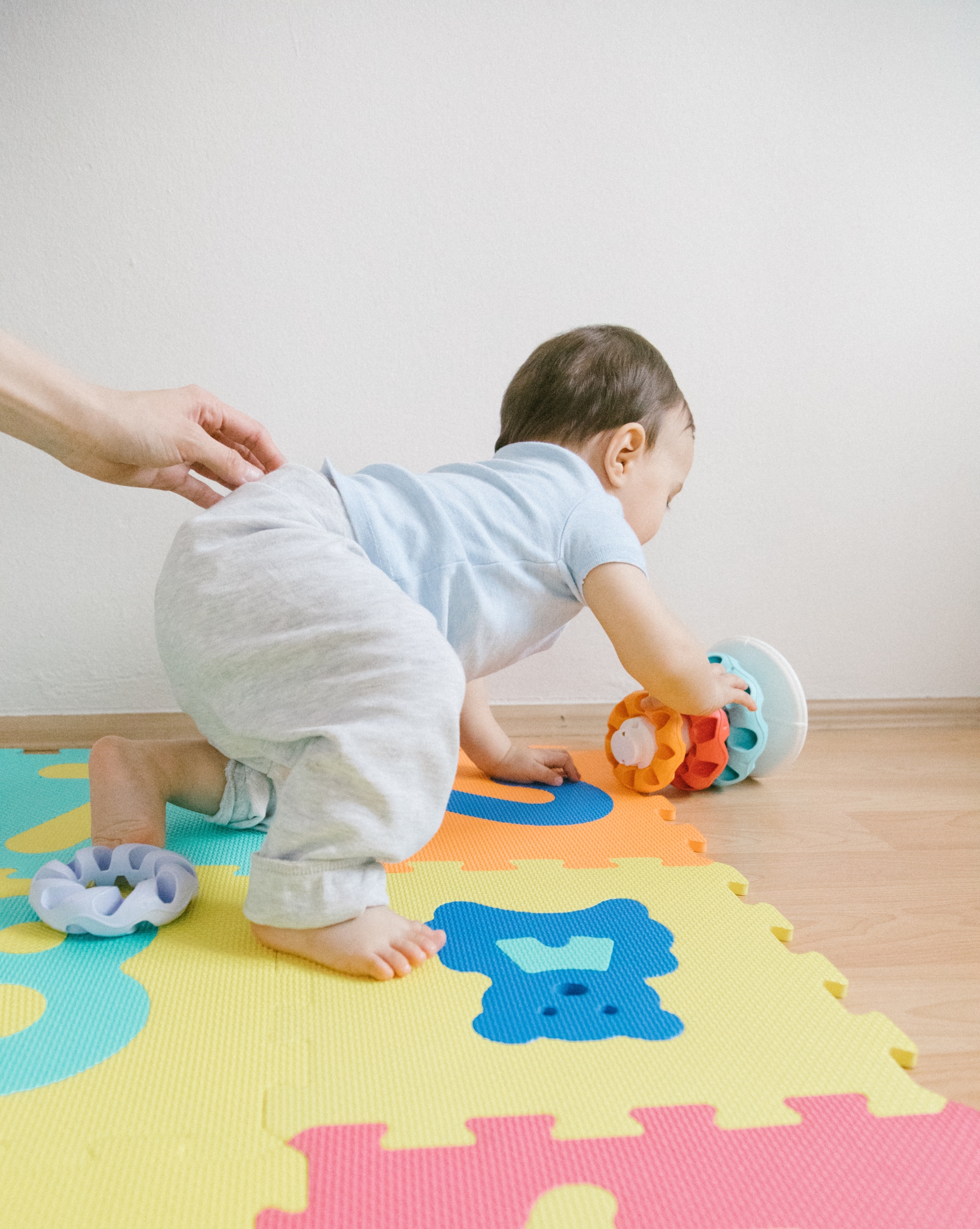
Many babies will crawl in a typical all fours pattern, but there are so many variations too. Some babies will first commando or army crawl before getting up on hands and knees. This is where we often see lots of different variations and asymmetries. Some babies will do lot of pulling with their arms and some will always push off with the same leg. I generally tell parents not to worry about funny looking army crawl patterns. It will work itself out when the babies are on hands and knees crawling and moving in a much more symmetrical and synchronized way.
Some babies will bear crawl, where the legs are kept straight. This often happens when the baby is avoiding hard floors! As long as you’re seeing lots of variety of movement patterns during play, this isn’t concerning.
Crab crawl: Baby moves with either one or both legs tucked under. This is another common variation. Its often due to asymmetries in the pelvis and hips, but it can also just be a normal variation.
Bottom scoot: Baby uses hands to push across the floor while sitting upright on their bottom. Some babies don’t go onto hands and knees at all and will get around on their bottoms. If baby is choosing this method of mobility, keep an eye out for how they are figuring out how to pull up to standing so that they are able to get to the next stages of development on the road to walking. My favorite activity to introduce to bottom scooters is climbing up the stairs- you can’t pull that off with a bottom scoot!
Crawling backwards: many babies will crawl backwards before figuring out how to crawl forwards; if you see your baby crawling backwards, just enjoy the process and watch them problem solve and figure out how to change directions; they’re almost there!
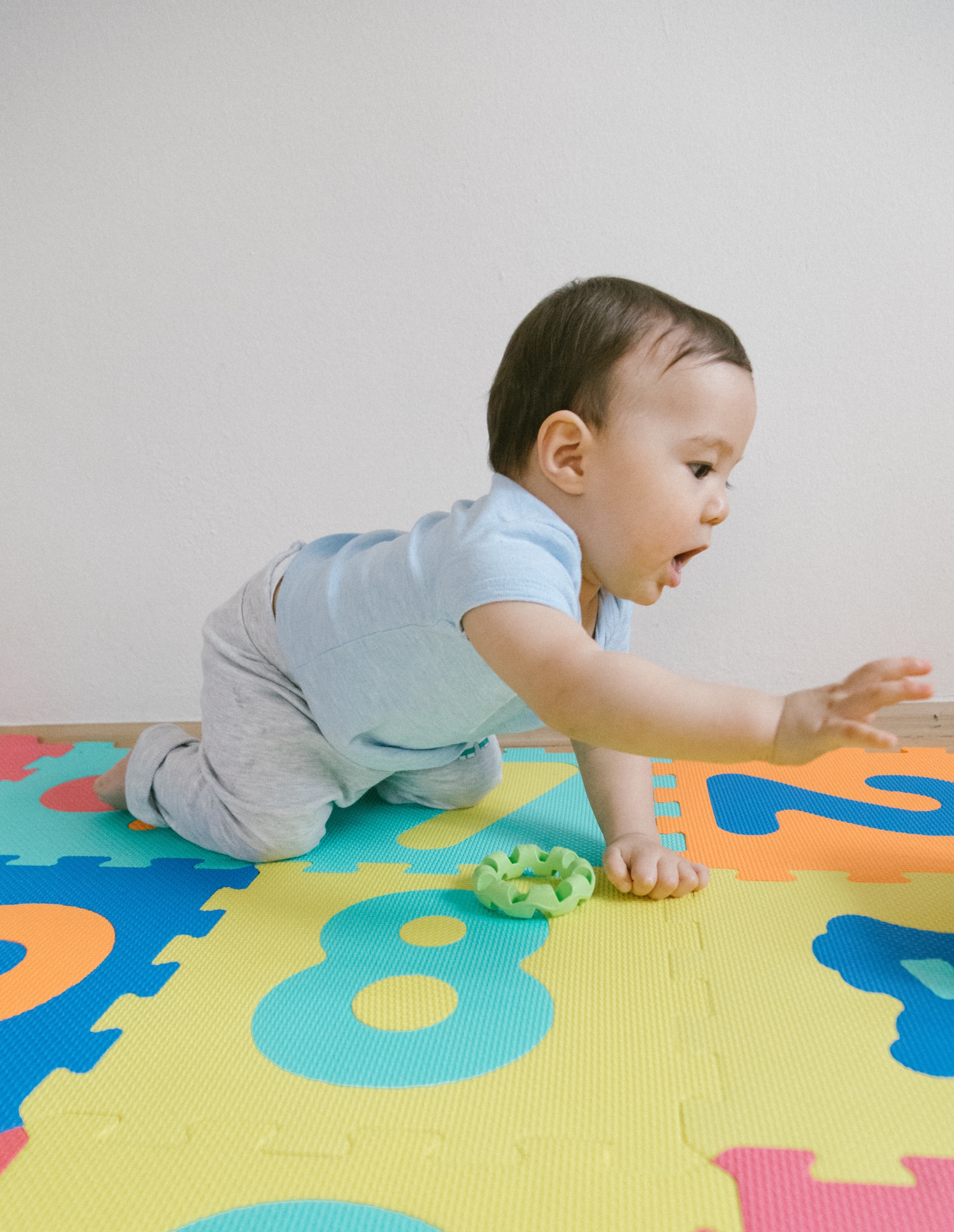
Babies will learn to crawl on hands and knees between 8-10 months of age. Like every milestone baby works towards, there are many small steps that add up to the big achievement of the milestone. If a baby is able to do all the steps up to crawling, such as moving from sitting to hands and knees and rocking on hands and knees, they’re on their way.
Some signs baby may need some help with their gross motor development:
At Kid PT we offer developmental screenings to local families who have questions or concerns about their children’s development. I tell parents that at that screening you will either get peace of mind that there aren’t any concerns or they’ll get recommendations as to how to help their child and support their development. Its a win-win!
To schedule a Developmental Screening, call/text us at 908-543-4390 or email info@kidpt.com.
What happens when your child is ill?
Have you ever thought you were going crazy when it came to your kids? Sure, we all get stressed out by the demands parenting requires of us whether they be mundane, daily happenings (“No you can’t have another cookie!”, “Stop teasing your brother!”) or extreme, unlikely circumstances (Hello pandemic-looking at you!)
But, what if there was something wrong with your child, (who also happens to have neurodevelopmental delays or another neurodivergent diagnosis) and no experts had any answers for you? What if you took your kiddo to all the “BEST” doctors out there and they either had no answers, their diagnosis conflicted with one another, or worst of all, they just didn’t believe your child had a problem?
Misdiagnosis happens.
I am here to tell you that it happens. And when it is your child who is struggling and suffering, it is exquisitely painful. You feel like you are living in a nightmare that you simply cannot wake from and that somehow, those around you are seeing a distorted view of reality. A 2019 article* states that, “the mindset that young children are rarely seriously ill is one of the main reasons that they are more likely to be misdiagnosed than adults are. That’s on top of all of the ways that approximately 10 percent of American adults are misdiagnosed every year. When doctors and nurses expect to see a healthy child with a common short-lived illness, they may miss the uncommon ones.”
The article goes on to list the main reasons for children receiving a diagnosis that’s wrong or delayed:
Experts may give you the brush off.
However, there are cases where a parent’s concerns are dismissed, as I was when my daughter presented with a long, puzzling, seemingly unrelated laundry list of symptoms that spanned years, nearly a decade by the time a diagnosis was finally rendered. During that time period, I was given advice from some well-meaning individuals who said things like:
Did any of this help my daughter get better or me find answers? That would be a resounding no. Oh, and by the way, that last piece of “advice” above was given to me, in front of my child, by a supposedly well-respected doctor. He dismissed all the hundreds of pages of tests, scans, medical records and prior diagnosis, didn’t help my daughter, and charged for it!
So what DO YOU DO? You don’t give up- you trust your gut! Parents know their children best and what their “normal” looks like, even if it doesn’t match the textbook image. Remember to believe in yourself and your ability to help your child. Make a bulleted list of every symptom, even if it does not seem totally related, and the date the symptom started. Research the heck out of your child’s symptoms and any test results you have, using the best and most trusted resources you can find. Become well acquainted with clinical research papers, societies for various branches of disease types ( think brain, stomach, nervous system, etc.) Join an online group for other parents who may be seeking answers for their child or who may have information to share.
The Society to Improve Diagnosis in Medicine says not to get overwhelmed by the risks of misdiagnosis. Rather, recognize there are a few key things to do, to assist in getting an accurate and (hopefully) prompt diagnosis. These tips also help if your child is in the middle of a diagnostic journey today.
In closing, you, as a parent, are the most trusted authority on your child. If you feel that something is wrong with your child and it is not getting resolved, don’t be afraid to speak up. Your child and your family deserve answers and the best possible care. Be brave and know that what your GUT is telling you, may be right. (If you have a question for Melanie (author/Kid PT Marketing) email her at info@kidpt.com)
*References
